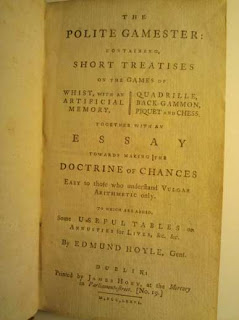 |
| Payne's Maxims for Whist Levy [1338] |
There is a hint of the publishers' strategy in the 1775 edition. The book expanded the section on whist to include the text of another work, Maxims for Playing the Game of Whist, London 1773. Maxims, by William Payne, was the second book in English on the game of whist after Hoyle. It sold well with two more editions appearing in 1778 even though it also appeared within the 1775 Hoyle's Games Improved.
HGI also added thirty pages about new games (billiards, cricket, Tennis quinze, hazard and lansquenet) to the two hundred pages of Hoyle's original writing. Of most interest is the inclusion of the newly revised rules of cricket:
Printed by Permission of Mr. Ridley in St. James's-Street. The Laws of Cricket; Revised at the Star and Garter, Pall-Mall, February 25, 1774, by a Committee of Noblemen and Gentlemen of Kent, Hampshire, Surry, Sussex, Middlesex, and London. (page 210)Mr. Ridley was the last-listed publisher in the consortium and was contributing his rights to the cricket laws which had been printed separately in 1775.
That strategy of incorporating separately printed gaming works into Hoyle's Games Improved continued in 1779 with the inclusion of several important works.
The first example is an entirely new and greatly expanded section on billiards. "Marker" John Dew wrote a treatise on the game of billiards which he sold to a member of the consortium for four guineas in August, 1776 (British Library Add. 38728 f.55). The book was was not published until 1779, when the consortium issued it both separately and as part of Hoyle's Games Improved. An engraved plate with two views of the fortification billiards table appeared in both books.
 |
| The Perspective View of Fortification Billiards |
The second is another work by William Payne, "teacher of mathematics." Today, Payne's An Introduction to the Game of Draughts (London 1756) is most remembered for the preface which has been conclusively attributed to Samuel Johnson. (Fleeman 56.1PD/1) A receipt has survived documenting the sale of the Draughts copyright to a member of the consortium:
London Feb. 11 1779. In consideration of the Sum of Five Pounds and five Shillings by me this day received from Thomas Lowndes I do sell Leave to the said Thomas Lowndes & Partners a right to print for ever in a Book called Hoyles Games a Pamphlet called the Game of Drafts as written by my late Brother William Payne. Witness my Hand. Tho. Payne (British Library, Add. 38728 f.168)Lowndes was another member of the publishing consortium.
The proprietors advertised the book on November 13, 1779 in the London Chronicle:
The advertisement highlights the new authors and the inclusion of engravings.This day was published, a new edition, in 12mo, price 3s. only, Hoyles Games Improved: Being practical treatises on the following fashionable amusements, viz. Whist; Quadrille; Piquet; Chess; Back Gammon; *Drafts, by Mr. Payne, with the figure of a Draft Table; *Cricket, as now played by the nobility and gentry; *Tennis; *Quinze; *Mr. Payne's Maxims of Whist; *Hazard; *Lansquenet; *Billiards, by Mr. Dew, with plates...Notes are given to illustrate the games by Hoyle; and those marked * are additional improvements. Revised and corrected by Charles Jones, Esq...N. B. Mr. Dew's Treatise on Billiards may be had separate, price 1s. sewed.
 |
| Jones.2 Levy [1746] |
References
- J. D. Fleeman. A Bibliography of the Works of Samuel Johnson. Treating his published works from the beginnings to 1984. (Oxford: Clarendon Press. 2000).
























